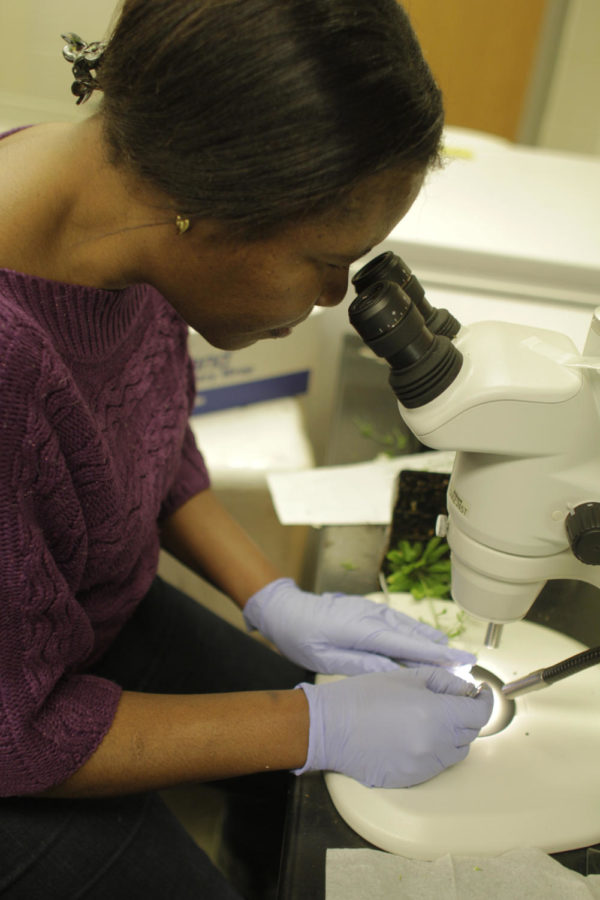ISU researches Sudden Death Syndrome-causing fungus in soybeans
Kelby Wingert/Iowa State Daily
Micheline Ngaki, postdoc research associate for agronomy professor Madan Bhattacharyya, works on cross-pollinating two soybean plants. Bhattacharyya is leading a team of researchers in a program to research the fungus that causes Sudden Death Syndrome in soybean plants.
January 27, 2014
Iowa State University has recently conducted genome sequencing for a fungus that causes Sudden Death Syndrome in soybean plants.
Madan Bhattacharyya, associate professor of agronomy, is the leader of the soybean research team. Bhattacharyya and other colleagues proposed the research idea in the annual “Soybean Sudden Death Syndrome” meeting, which was held in 2009.
The director of the North Central Soybean Research program, David Wright, liked the idea of the project and funded the research project in 2010. The project cost less than anticipated, and the team had a small amount of researchers.
The soybean research team is diverse and has a variety of experience levels. The team consists of four graduate students, six postdoctoral scientists, one assistant scientist, a scientist from Turkey and four undergraduate students.
The pathogen Fusarium virguliforme causes Sudden Death Syndrome and was first reported in Arkansas in 1971. Data shows that the pathogen has spread to the northern U.S. states and has even spread to Canada. Minnesota, Wisconsin and Michigan are three out of 17 states that have been hit recently.
The pathogen is a major threat to crop production. In 2010, 2.1 percent of soybean yield was infected by Sudden Death Syndrome. Around $820 million was wasted in the United States because of the pathogen.
Iowa was also affected by the soybean loss in 2010. Around $300 million worth of Iowa’s soybeans were infected. There are no effective chemicals to spray on the crops, and by the time the plants show any symptoms, it is too late to do anything to save the crops.
Iowa State University is trying to learn how the pathogen infects the soybean species. The team is trying to figure out the function of each gene that might play a role in the Sudden Death Syndrome development.
“Low cost and the growing importance of this serious pathogen were two motivating factors in pursuing the project,” Bhattacharyya said.
Research of this kind might lead to the engineering of the Sudden Death Syndrome resistance gene in transgenic soybean plants.
The researchers on the project conducted a draft genome. A draft genome is the genome sequencing of the pathogen, which identified 1,332 genes unique to the soybean Sudden Death Syndrome. Sequencing is helping others around the globe to also conduct similar research.
“To our knowledge, this pathogen does not infect other plant species, but there might be a disease similar to this in other species,” Bhattacharyya said.
The research will help to answer other questions related to the pathogen. The comparing of genomes will be very beneficial to future research.
The research lab has been receiving funds from the Iowa Soybean Association since 2000. The program has also received funds from the United Soybean Board and North Central Soybean Program.
Educating the community and the world about the research findings are very important to the continuity of the project. The data is presented at national and international meetings, and the sequence data is deposited in the National Center for Biotechnology Information. The information is also published in professional papers.

















